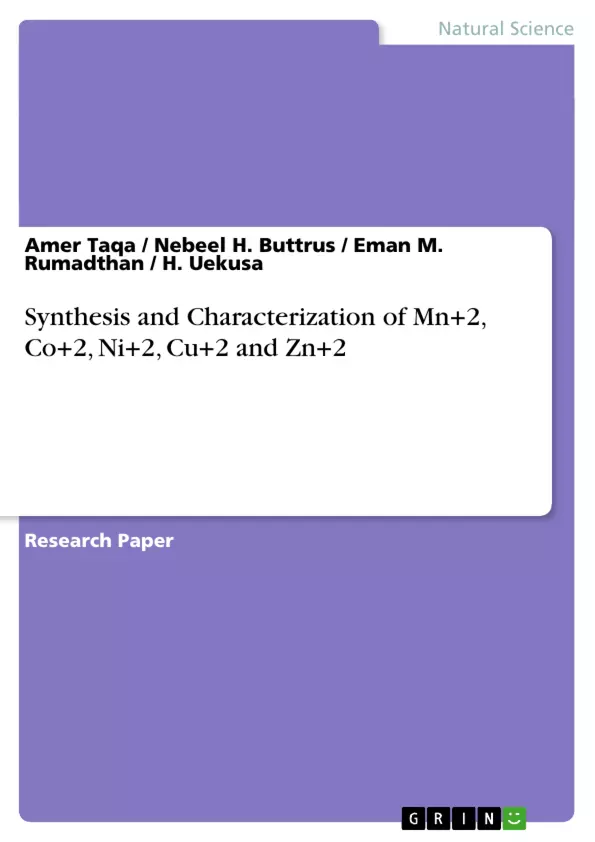A series of new complex salts of the type [A]2[MCl2I2] where A=1,3,5-trimethylpyridinium cation, M= Mn+2,Co+2, Ni+2,Cu+2 and Zn+2 were prepared by the reaction of the metal chloride and 1,3,5-trimethylpyridinium iodide in (1:2) molar ratio and characterized by elemental analysis, molar conductance, IR, Uv/Vis., spectral studies and magnetic measurements. The crystal structure of 1,3,5-trimethylpyridinuim iodide was determined by single crystal x-ray crystallography.
The structure of the anion part and a 1,3,5- trimethylpyridinium cation which crystallizes in the orthorhombic space group (Cmcm) with a=8.9850(9), b=15.767(2), c=6.9940(6)A°, V=990.82 (16)A°, Z=4. Which is on a crystallographic mirror plane perpendicular to C-axis except for methyl hydrogen atoms. The anion and cation are connected through hydrogen bonds between I and the cation by hydrogen bonding, electrostatic interaction and weak π-π interaction are also expected.
Inhaltsverzeichnis (Table of Contents)
- INTRODUCTION
- EXPERIMENTAL
- SYNTHESIS
- 1,3,5-trimethylpyridinium iodide
- Preparation of [C8H12N]2[MnCl2I2]
- [C8H12N]2[C0Cl₂I2]
- [C8H12N]2[NiCl2I2]
- [CgH12N]z[CuCl
- [C8H12N]2[ZnCl2I2]
- Crystallography
- RESULTS AND DISCUSSION
- Infrared spectra
- Magnetic measurements
- Electronic spectra
- Crystal structure
Zielsetzung und Themenschwerpunkte (Objectives and Key Themes)
This study aims to synthesize and characterize a series of new complex salts of the type [A]2[MC1212], where A=1,3,5-trimethylpyridinium cation, M=Mn+2, Co+2, Ni+2, Cu2 and Zn+2. The research focuses on the synthesis and characterization of these complex salts, as well as the determination of the crystal structure of 1,3,5-trimethylpyridinium iodide using single crystal x-ray crystallography.
- Synthesis and characterization of complex salts involving transition metals and a pyridinium cation.
- Structural analysis and crystallographic characterization of 1,3,5-trimethylpyridinium iodide.
- Investigation of the physical properties and spectroscopic behavior of the complex salts.
- Exploration of the role of hydrogen bonding, electrostatic interactions, and weak л-л interactions in the crystal structure.
- Comparison of the properties of the complex salts with similar compounds reported in literature.
Zusammenfassung der Kapitel (Chapter Summaries)
The study begins with an overview of the interest in transition metal halide complexes and their applications in diverse fields. The research provides a comprehensive experimental section detailing the synthesis of 1,3,5-trimethylpyridinium iodide and the complex salts. The chapter further explains the methods used for characterization, including elemental analysis, conductivity measurements, IR, UV/Vis spectroscopy, and magnetic measurements.
The results and discussion section analyzes the properties of the complex salts, including their stability, conductivity, and spectroscopic behavior. The study also discusses the crystal structure of 1,3,5-trimethylpyridinium iodide in detail, including the arrangement of atoms, intermolecular interactions, and comparison with previous reports.
Schlüsselwörter (Keywords)
This research centers around the synthesis, characterization, and structural analysis of complex salts involving transition metals (Mn+2, Co+2, Ni+2, Cu+2, and Zn+2) and the pyridinium cation, specifically 1,3,5-trimethylpyridinium. Key themes include the role of intermolecular interactions, like hydrogen bonding, electrostatic interactions, and weak л-л interactions, in crystal structure determination. The study also explores the correlation between structural characteristics and the spectroscopic properties of the complex salts. The research utilizes various analytical techniques such as IR spectroscopy, UV/Vis spectroscopy, magnetic measurements, and single crystal x-ray diffraction.
- Quote paper
- Amer Taqa (Author), Nebeel H. Buttrus (Author), Eman M. Rumadthan (Author), H. Uekusa (Author), 2012, Synthesis and Characterization of Mn+2, Co+2, Ni+2, Cu+2 and Zn+2, Munich, GRIN Verlag, https://www.hausarbeiten.de/document/209002


